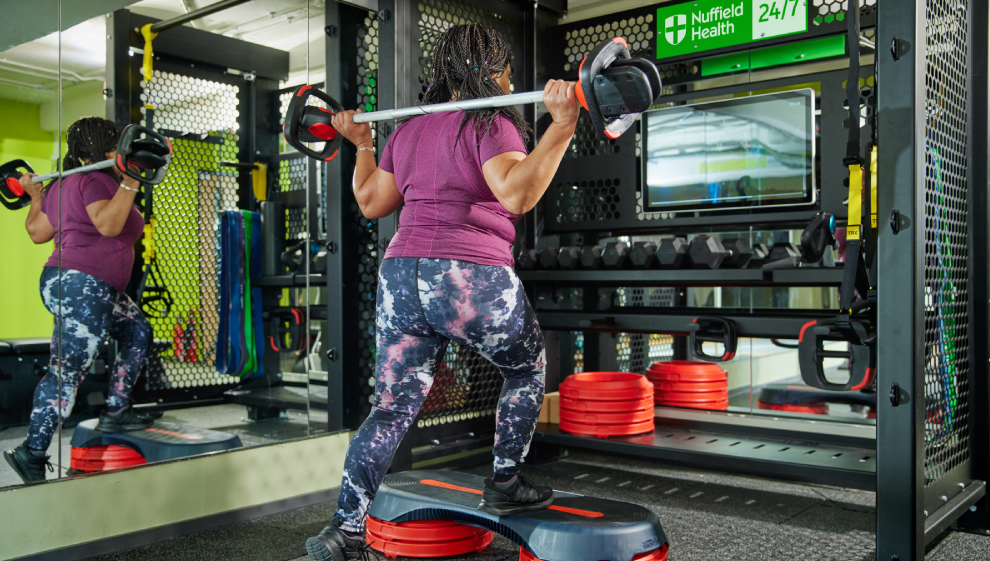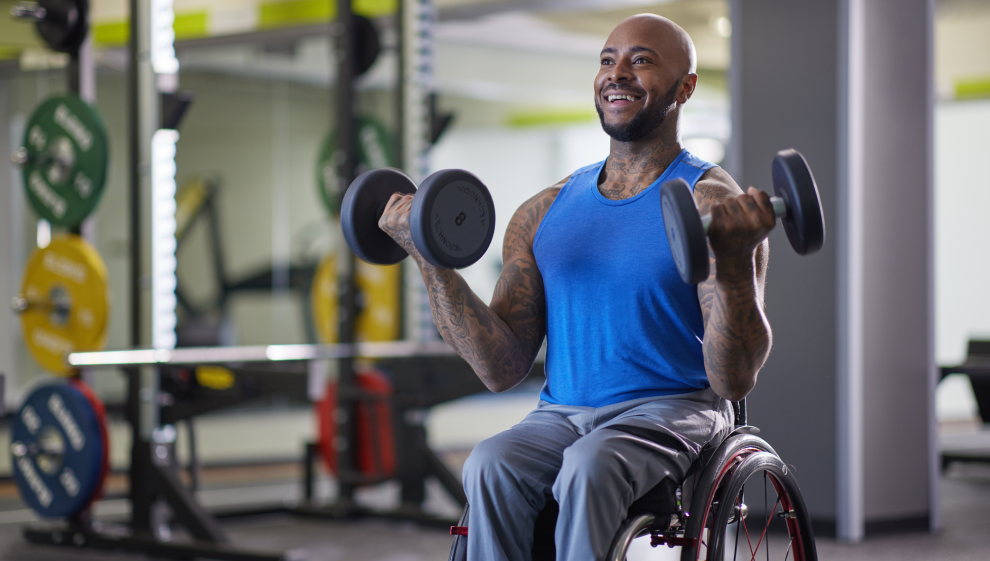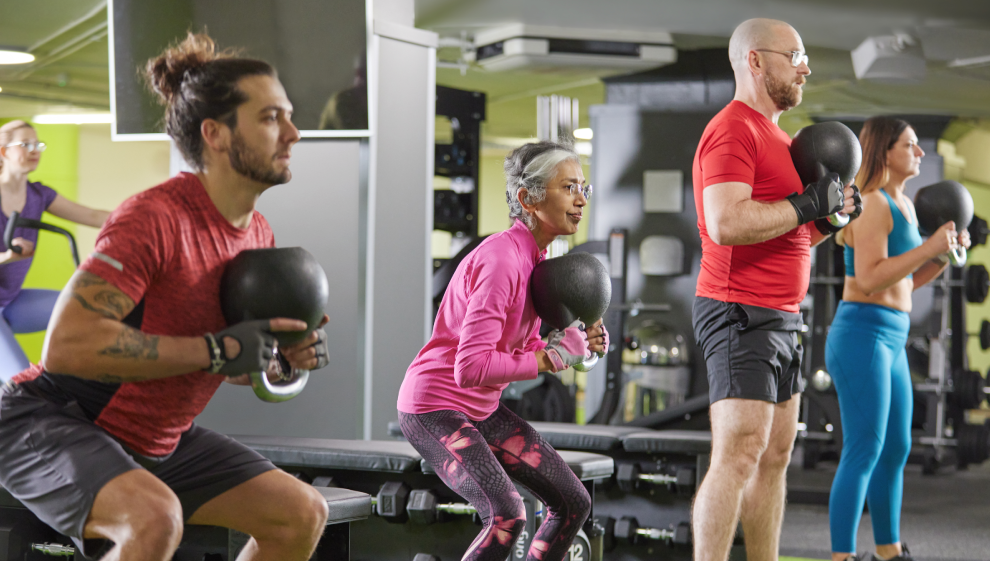Busting resistance training myths
- Overview
- 1. It will make me look bulky
- 2. Resistance training can be painful
- 3. I’ll have to go to the gym every day
- 4. The weights area is for men
- 5. Resistance training is for skinny people
- 6. It’s all about aesthetics
- 7. Resistance training is only for athletes
- 8. Resistance training will make you vain
- 9. Resistance training causes injuries
- 10. You can’t train if you have a health condition
- 11. I'll need expensive gym clothes
- 12. Resistance training isn't for older adults
- 13. I’m fit so I can avoid resistance training
- 14. I have to be strong to start
- Related articles
1. It will make me look bulky
This misconception stems from the inaccurate idea that lifting weights and putting on muscle will make you look bulky.
This false narrative is harmful, as it actively dissuades and puts off people who are not interested in potentially adding muscle or size to their physique.
The truth is that putting on a significant amount of muscle requires serious work. There needs to be a lot of focus on increasing your calories to match the level of work you are doing and it isn’t easy.
Many fitness professionals go to the gym three or four times a week to lift weights and do not consider themselves to be overtly muscular. If you’re concerned about adding muscle, understand that it is not easy and focus on building strength and meeting the goals you’ve set for yourself.
2. Resistance training can be painful
If you start lifting weights that are too heavy for you, or an intense routine that’s too advanced for you, you’re likely to experience some degree of muscle ache. This is because your muscles need time to adapt to a new way of moving and the increased load they’re working through.
If you’d just taken up running for the first time, you wouldn’t try and run a marathon after two weeks. Start slowly and gradually increase the intensity of your resistance training.
Some degree of muscular ache or soreness is to be expected, as this is a sign you’re working the muscles involved in your routine. This is what trainers call DOMS (delayed onset muscle soreness) which often sets in 24 to 48 hours after a workout.
To avoid severe pain and injury, start slow. Enlist the help of a personal trainer or ask a friend with experience about getting started the right way. Starting small and adding weight over time is the best way to start a resistance training programme.
3. I’ll have to go to the gym every day
This is also not true.
In between sessions, we recommend moving and trying to be as active as you can in daily life. This might mean active stretching (yoga or Pilates), walking, or doing another form of gentle cardio.
Avoid working out in a dedicated fashion every day of the week as this can lead to overtraining. If you are going to the gym every day, you are likely overtraining and not giving your body the rest it needs to recover between workouts.
You also need to rest certain muscle groups, as growth happens in the rest days when you are recovering. When we train the same muscle group over and over without rest, we greatly amplify our risk of injury.
4. The weights area is for men

Guidance from the UK Chief Medical Officers says otherwise.
Claiming your space in the gym helps build confidence and reinforces the idea that exercise and all forms of training are for everyone. The weights area might be full of men, but by embracing resistance training as a woman, you can do your bit to change this ratio.
If you’re apprehensive about a certain area in the gym or you feel like you don’t know what you’re doing, working with a personal trainer or booking an induction can give you the confidence you need to claim your space and make use of all the equipment on offer.
5. Resistance training is for skinny people
Shattering this misconception that there are only certain types of people who can do resistance training is really important.
When you decide that something isn’t for you, you disassociate yourself from something that could really benefit you in the long term.
If you’d love to lift weights or try strength training out, focus on the many benefits. Nothing is stopping you from getting started with some accessible, low-weight exercises that might just kickstart a real interest in resistance training.
6. It’s all about aesthetics
This couldn’t be further from the truth.
It’s impossible to estimate or quantify the goals of every single person in the gym. Some people do train to change the composition and look of their body (and that’s okay), but resistance training is about so much more than just this.
Other common training goals amongst people who use resistance training include:
- Training for longevity
- Increasing mobility and ease of movement
- Building strength
- Improved posture
- Functional fitness
- Joint health
- Increased bone density
- Added flexibility
You should find and focus on your own goals and incentives, and use them as your motivation to get started and stick with it.
7. Resistance training is only for athletes

Whilst strength and resistance training is brilliant for athletic performance in professional settings, the benefits they enjoy are available to everyone.
You’re likely not going to be training as much as a professional athlete, but the benefits you get are going to ensure you stay healthier for longer.
There are many strength training programmes out there that will mimic the workouts and sessions done by professional athletes. This gives you a taste of what the best in the world are doing in the gym and lets you see how accessible the workouts they’re doing regularly really are.
8. Resistance training will make you vain
This false assumption helps promote an unfair view of people who use strength training in their workouts. Some people might enjoy seeing changes in their body, but that’s just one small benefit of what resistance training can do.
People train for reasons that are important to them. What motivates one person may be inconsequential to the next as we’re all so different.
Some people are looking for assistance recovering from illness or injury, others train for confidence, others look to resistance training to maintain good mental health and others appreciate the preventative benefits on offer.
9. Resistance training causes injuries
It is important to receive guidance before you take part in strength training.
This is because it requires some awareness of form around the movement. Lifting weights with your knees turned in for example may cause some pain if done repeatedly over a period of time.
10. You can’t train if you have a health condition
Depending on your condition, physical activity is actually one of the best things you can do for your body.
The most important thing for you to remember is that it’s all about adaptation. Instead of stopping your usual workout routine, you might be better served making a few changes to get the most out of your sessions.
For some conditions, more guidance will be needed so you don’t feel unwell when you exercise. For example, if you have a cardiac or heart-health condition or are recovering following a cardiac event, you may need supervision and guidance from an exercise physiologist, physiotherapist, or level 4 trained cardiac rehabilitation Personal Trainer.
This is why we developed clinical programmes to support those who need further support and guidance. These programmes include our COVID-19 Rehabilitation programme, our Joint Pain Programme, and the Helping Hearts & Minds cardiac rehabilitation programme.
It’s key to remember though, that having a pre-existing health condition doesn’t typically mean resistance and strength training should be avoided. If you’re unsure if you should be doing resistance training, speaking to a GP is a good place to start.
11. I'll need expensive gym clothes
The way you look and the practicality of what you’re wearing are two very different things. If you’re wondering what to wear to the gym to maximise comfort and performance, try lightweight breathable fabrics that don’t restrict movement.
There’s no need to break the bank on gym clothes. Wearing expensive outfits won’t boost performance or give you better results. Thankfully, there are plenty of websites and high stress outlets that offer affordable options for those looking for low-cost gym wear.
For women, it’s important you wear a good sports bra that gives you support for the movements you are doing. Experts advise going for a high support sports bra when doing cardio or anything that involves high impact.
Lastly, choose an outfit that makes you feel confident. This can help you concentrate on your workout and pull your focus away from anxiety in the gym about what you look like or what you’re wearing.
12. Resistance training isn't for older adults

This simply isn’t true. Resistance training at a pace that works for you is about so much more than getting “fit” or “strong”.
In fact, because we gradually lose muscle over time (sarcopenia), it’s important that older adults (65+) aim to complete activities that help improve or maintain muscle strength and mass as they continue to age.
If you’re in this age bracket and are curious about the benefits of resistance training, speak with a personal trainer at your local gym. They’ll be happy to help you find exercises that work for your ability and physical condition. This way, you avoid the risk of injury and damaging your joints.
13. I’m fit so I can avoid resistance training
That’s great. You should continue to stay active and maintain your current activity level, but it is recommended that you include some resistance training to reap the benefits of staying fitter and healthier for longer.
For runners, you should supplement your training with activities that will strengthen the muscles around their joints. This will help prevent injury and even give more health benefits that increase your running performance.
14. I have to be strong to start
Strength is developed over time and you likely won’t find yourself getting dramatically stronger when you first start. This isn’t always the case, as some people’s genetic makeup means they can put muscle mass on very quickly.
Some people lift heavier than they should when they first start and overdo it out of fear of being judged for using lighter weights. The truth is that everyone is in the gym for different reasons.
You will have experienced and strong people in the gym lifting much lighter weights so they can recover from injury. Lifting lighter allows them to work on their endurance/conditioning. They’re also being sensible and listening to their bodies.
It’s always best to stick with what works for you rather than worrying about what others think.
Last updated Wednesday 24 January 2024
First published on Wednesday 24 January 2024

